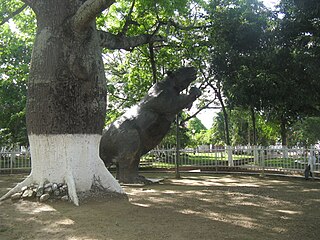Phoberocyon is a large extinct genus of hemicyonine bear, found primarily in North America during the Miocene. It lived from 28.4 to 13.7 mya, existing for approximately 14 million years. One species, P. hispanicus, is known from Miocene Spain.
The South American land mammal ages (SALMA) establish a geologic timescale for prehistoric South American fauna beginning 64.5 Ma during the Paleocene and continuing through to the Late Pleistocene. These periods are referred to as ages, stages, or intervals and were established using geographic place names where fossil materials where obtained.
The Santacrucian age is a period of geologic time within the Early Miocene epoch of the Neogene, used more specifically with SALMA classification in South America. It follows the Colhuehuapian and precedes the Friasian age.
The Laventan age is a period of geologic time within the Middle Miocene epoch of the Neogene, used more specifically within the SALMA classification in South America. It follows the Colloncuran and precedes the Mayoan age.
The Chasicoan age is a period of geologic time from 10–9 Ma within the Late Miocene epoch of the Neogene, used more specifically within the SALMA classification in South America. It follows the Mayoan and precedes the Huayquerian age.
The Huayquerian age is a period of geologic time within the Late Miocene epoch of the Neogene, used more specifically within the SALMA classification. It follows the Chasicoan and precedes the Montehermosan age.

Chelonoidis is a genus of turtles in the tortoise family erected by Leopold Fitzinger in 1835. They are found in South America and the Galápagos Islands, and formerly had a wide distribution in the West Indies.

The Pisco Formation is a geologic formation located in Peru, on the southern coastal desert of Ica and Arequipa. The approximately 640 metres (2,100 ft) thick formation was deposited in the Pisco Basin, spanning an age from the Middle Miocene up to the Early Pleistocene, roughly from 15 to 2 Ma. The tuffaceous sandstones, diatomaceous siltstones, conglomerates and dolomites were deposited in a lagoonal to near-shore environment, in bays similar to other Pacific South American formations as the Bahía Inglesa and Coquimbo Formations of Chile.
Cainochoerinae was a subfamily of even-toed ungulates that existed during the Miocene and Pliocene in Asia and Africa.
Albanohyus was an extinct genus of even-toed ungulates which lived during the Miocene in Eurasia and possibly Africa.
Cainochoerus was an extinct genus of even-toed ungulates which lived during the Miocene and Pliocene in Africa. Fossils have been found in Kenya, Ethiopia and South Africa.

Hyotheriinae was a subfamily of even-toed ungulates that existed during the Miocene and Pliocene in Europe, Asia, and Africa.
Nguruwe was an extinct genus of even-toed ungulates that existed during the Miocene in Africa. It was formerly considered a member of the subfamily Listriodontinae, but has since been placed in Hyotheriinae.
Xenohyus was an extinct genus of suids that existed during the Miocene in Europe.
Parachleuastochoerus was an extinct genus of even-toed ungulates that existed during the Miocene in Europe. It was a smaller descendant of the Conohyus genus, with narrower cheek teeth and reduced premolars.

The Honda Group is a geological group of the Upper and Middle Magdalena Basins and the adjacent Central and Eastern Ranges of the Colombian Andes. The group, in older literature also defined as formation, is in its present-day type section in the Tatacoa Desert in the department of Huila subdivided into two main formations; La Victoria and Villavieja.
Proterotherium is an extinct genus of litoptern mammal of the family Proterotheriidae that lived during the Late Miocene of Argentina and Chile. Fossils of this genus have been found in the Ituzaingó Formation of Argentina, and the Galera Formation of Chile.
Ramadapis sahnii was a primitive primate belonging to Sivaladapidae that existed around 11 to 14 million years ago. Only a mandible was found at the dig site, which was near Ramnagar in Udhampur district in Jammu and Kashmir specifically the lower Siwalik deposits. The jawbone indicates that Ramadapis resembled a modern day ring-tailed lemur. The early lemur was named after Ashok Sahni, who discovered the first sivaladapid in the Siwalik deposits. The mandible was only around one and a quarter inch long, which led scientists to assume that it was only around 11 pounds.





